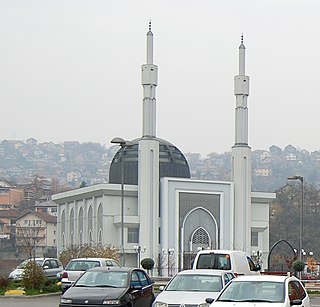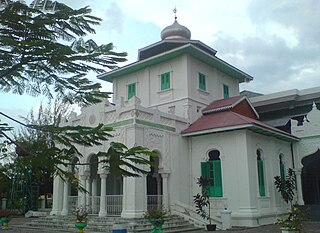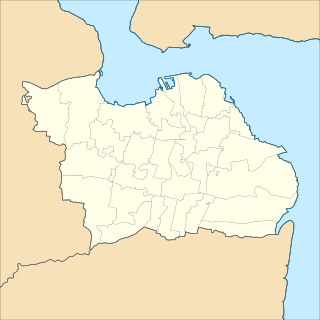
Istiqlal Mosque in Jakarta, Indonesia is the largest mosque in Southeast Asia and the sixth largest mosque in the world in terms of worshipper capacity. Built to commemorate Indonesian independence, this national mosque of Indonesia was named "Istiqlal", an Arabic word for "independence". The mosque was opened to the public on 22 February 1978. Within Jakarta, the mosque is positioned next to Merdeka Square and the Jakarta Cathedral.

The Taipei Grand Mosque is the largest and oldest mosque in Taiwan. Located in the Da'an District of Taipei City, it is Taiwan's most important Islamic structure.

The Great Mosque of Central Java is a mosque in the city of Semarang, Central Java, Indonesia.

The Ganting Grand Mosque is a Sunni mosque located in Ganting, Padang, West Sumatra, Indonesia. Construction began in 1805, making it the oldest in Padang and one of the oldest in Indonesia. It is a Cultural Property of Indonesia.

Istiqlal Mosque is one of the largest mosques in Sarajevo, Bosnia and Herzegovina. It was named after Istiqlal Mosque, Jakarta, the national mosque of Indonesia, since the mosque was a gift from the Indonesian people and government for Bosnia and Herzegovina as a token of solidarity and friendship between the two nations. The name "istiqlal" is Arabic word for "independence", thus it is also meant to commemorate the independence of Bosnia and Herzegovina. It is also colloquially known as "Indonesian mosque" or "Suharto mosque", as the credit to the initiator of the mosque construction.

Masjid Jami' Al-Makmur Cikini is located on Jalan Raden Saleh Raya in Cikini, Central Jakarta, and is one of the oldest mosques in the locality. It was formerly known as Tjikini Mosque.

Wapauwe Old Mosque is a historic mosque in Kaitetu village, a village in the Wawane Mountains on the north part of cape Keitetu, Maluku, Indonesia. Established in 1414, it is the oldest mosque in the Moluccas and possibly the oldest mosque in Indonesia which has been maintained in its original state.

The Great Mosque of Palembang, also known as Sultan Mahmud Badaruddin I Great Mosque after the former Sultan of Palembang, is the main mosque of Palembang, the capital of South Sumatra. The mosque is the largest in South Sumatra, and the third largest mosque in Sumatra after the Grand Mosque of West Sumatra and Great Mosque of Pekanbaru.

Azizi Mosque is a mosque located in Tanjung Pura, North Sumatra, Indonesia. It was the royal mosque of the Sultanate of Langkat.

Baiturrahim Mosque is a mosque located in Ulee Lheue, Meuraksa sub-district, Aceh Province, Indonesia. As a legacy of the Sultan of Aceh in the 17th Century, it is one of the historical mosques in Indonesia. Back then the mosque was named Jami Ulee Lheu Mosque. In 1873, when the Baiturrahman Grand Mosque was burned by the Dutch, all the worshipers held a Friday prayer at Ulee Lheue. Since then the name of the mosque became Baiturrahim Mosque.

Al-Markaz Al-Islami Mosque is a mosque located in Makassar, South Sulawesi, Indonesia. The construction begun in 1994 and the mosque was completed in 1996. With maximum capacity of 10,000 pilgrims, building area of 6,932 m2, and site area of 10,000 m2, it serves as one of the biggest centers of Islamic religious activity in Southeast Asia. The building has three floors and made of granite stones, and it faces Masjid Raya Makassar street.

Al-Akbar Mosque, also known as Great Mosque of Surabaya, is a national mosque located in Surabaya, East Java. It is the second largest mosque in Indonesia after Istiqlal Mosque in Jakarta in terms of maximum capacity. The location of the mosque is beside the Surabaya-Porong Highway Road. Its most distinctive feature is its large vertical dome, accompanied by four small blue domes. It also has a minaret with height of 99 meters, an ode to the 99 Names of Allah.

Dian Al-Mahri Mosque, also known as Golden Dome Mosque(Masjid Kubah Emas), is a mosque built on the edge of Raya street, Depok City in West Java, Indonesia. In addition to being a place of worship for everyday Muslims, this mosque complex is also a tourist area for family and attracts many people because of its domes made of gold. Because of the vastness of area and accessibility to the public, this place is often a holiday destination for family or a place to take a rest.
KH Hasyim Asy'ari Grand Mosque is a mosque at Semanan, Kalideres, West Jakarta, Indonesia. The mosque is named after National Hero of Indonesia Hasyim Asy'ari, the founder of the Nahdlatul Ulama. The mosque was inaugurated by Joko Widodo, President of Indonesia on 15 April 2017. The mosque is the first which is fully operated by Jakarta city administration.

An-Nawier Mosque is one of the oldest mosques in Jakarta, Indonesia. It is located at Pekojan, Tambora, a district of Jakarta. The mosque is a symbol of Arab civilization in Jakarta. The mosque is large and ancient architecture stands majestically in one densely populated settlement of West Jakarta. The settlement was once a region whose majority population is descended from Arabs, Yemen and India. Although the number of Arabs is now no longer prominent, but traces can still be found until now in Pekojan.

Mosque architecture in Indonesia refers to the architectural traditions of mosques built in the archipelago of Indonesia. Initial forms of the mosque, for example, were predominantly built in the vernacular Indonesian architectural style mixed with Hindu, Buddhist or Chinese architectural elements, and notably didn't equip orthodox form of Islamic architectural elements such as dome and minaret. Vernacular architectural style varies depending on the island and region.

The Great Mosque of Garut is a historical congregational mosque in the city of Garut, Garut Regency, Indonesia. The mosque is one of the oldest mosques in the region, first constructed on September 15, 1813 by the Dutch colonial representatives in the Priangan. The mosque was renovated three times in 1949, 1979, and 1998 into a traditional Javanese Islamic architectural style with sloped roofs.























